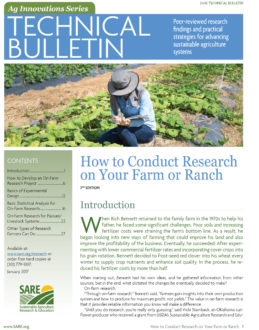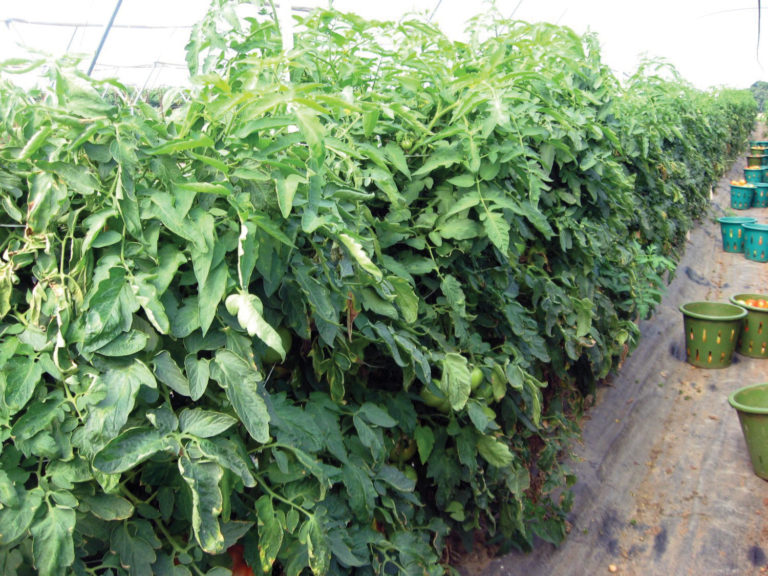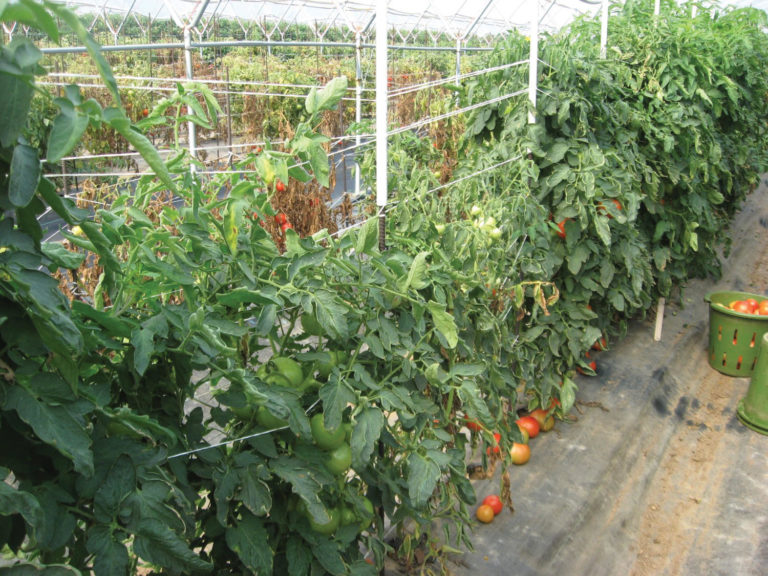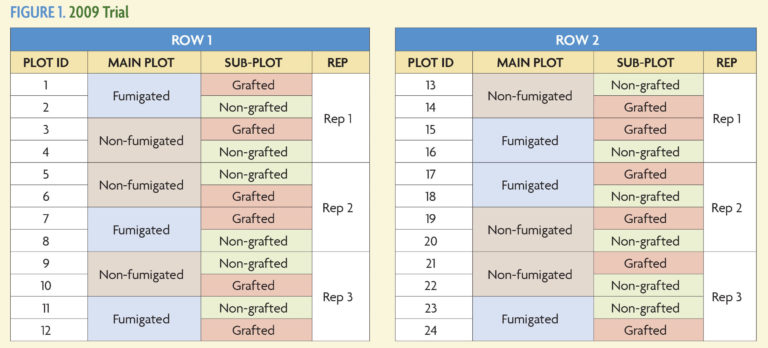Tomato Grafting for Management of Verticillium Wilt in High Tunnels
Note: This profile presents a true example of the kinds of problems that can arise in an on-farm research project. In this case, plots were not established correctly in year one, so while the generated data was sound, it was limited in its application. Good communication between the farmer and technical advisor helped reset the direction of the project in year two, and ultimately helped the farmer answer his questions regarding tomato production in high tunnels.
Steve Groff’s 225 acres at Cedar Meadow Farm in Lancaster County, Penn., includes two acres of multi-bay high tunnels, which help extend the growing season for a variety of vegetable crops. The high tunnels are quite productive, but Verticillium wilt, a disease caused by a soil-dwelling fungus, can become a significant problem in tomatoes. In an effort to explore alternative options to chemical fumigation, Groff developed an on-farm research project investigating the efficacy of grafted tomatoes to manage the disease.
Research Questions/Objectives
To help focus his research project, Groff came up with three questions:
- Does grafting with vigorous rootstock help tomatoes grown in high tunnels tolerate Verticillium wilt?
- What is the optimum plant spacing for managing grafted tomatoes to increase per plant productivity and help mitigate the added cost of grafted transplants?
- Can grafting be utilized as an alternative to soil fumigants for managing Verticillium wilt?
After reviewing research from North Carolina State University (NCSU), which showed that fruit yield of grafted plants in non-fumigated soil was similar to non-grafted plants grown in fumigated soil, Groff arrived at the following research hypothesis: Under high tunnel production where Verticillium wilt is present, grafted tomatoes will have better yields than non-grafted tomatoes.
Experimental Design
The research was conducted over two years, in 2008 and 2009. In the first year, prior to consulting his technical advisor, Groff set up two rows with the intention of answering the three research questions outlined above. He divided each row into four replications (blocks), with the treatment (plant spacing) and sub-treatment (grafted versus non-grafted tomatoes) completely randomized within each replication. However, he fumigated one whole row and left the other row un-fumigated. Because fumigation was not applied randomly to the individual replications in both rows, Groff could not conclusively determine whether it had a signification effect on the presence of Verticillium wilt. In order to account for any bias caused by the rows (e.g., location, irrigation issues, etc.), the fumigation treatment should have been applied randomly to both rows. So in 2008, although Groff ended up with valuable information about grafting and plant spacing, he did not properly address the question of whether grafting can be used as an alternative to fumigation.
After consulting with his technical advisor, Groff was able to fumigate sections of both rows in order to follow proper experimental design for 2009 (Figure 1). In both years, a split-plot (randomized complete block) design was used to test the hypothesis and answer the research questions. Groff started with two 300-foot rows within the high tunnel. Then, the main plots (plant spacing in 2008 and fumigated versus non-fumigated in 2009) were assigned to the rows. Both grafted and non-grafted tomatoes were planted in each main plot and were the sub-plot treatments. To evaluate the effect of the treatments, Groff measured the following: 1) marketable fruit number, 2) marketable fruit weight and 3) disease incidence using a scale developed by his technical advisor. Plant samples were also collected at final harvest to verify that Verticillium dahliae was present within symptomatic plants. All tomatoes were planted at the same time and managed in the same way throughout the growing season.
Statistical Analysis and Findings
A split-plot factorial ANOVA and an LSD test were used to evaluate the field data. Based on the results of Verticillium wilt incidence and marketable fruit weight, fumigation did not have an apparent impact on crop yield. Therefore, the results of the fumigated and un-fumigated experiments were combined in 2008 to illustrate main effects of grafting and plant spacing. The data shows that the grafted plants produced significantly more fruit yield through increased fruit size and number (with 99 percent confidence). Furthermore, crop productivity per acre was maintained even as plant spacing increased. Because the impact of fumigation could not be assessed in the 2008 study, Groff was not able to determine if the yield increases seen as a result of grafting were directly attributed to tolerance of Verticillium wilt. However, they did show that even under severe disease pressure, the grafted plants performed very well. The results from 2009 showed that grafted plants responded differently to fumigation than non-grafts, therefore supporting the hypothesis that the grafted plants had tolerance to this devastating disease. Based on the results of this project, Groff expanded the use of grafted tomato transplants from 500 plants to 8,000 plants in the next season, and continues to utilize grafted plants in his tunnels today.
Project Team
Groff received technical assistance as well as plant material for this project from Cary Rivard, who at the time was a graduate research assistant working with NCSU professor Frank Louws. Rivard coordinated transplant production, experimental design, data collection and statistical analysis. To learn more about this project, including an analysis of the data, visit SARE's project reports database and see project FNE08-636.
LEARN MORE
Read the SARE fact sheet, Tomato Grafting for Disease Resistance and Increased Productivity.
Profile written by Cary Rivard, Kansas State University.



